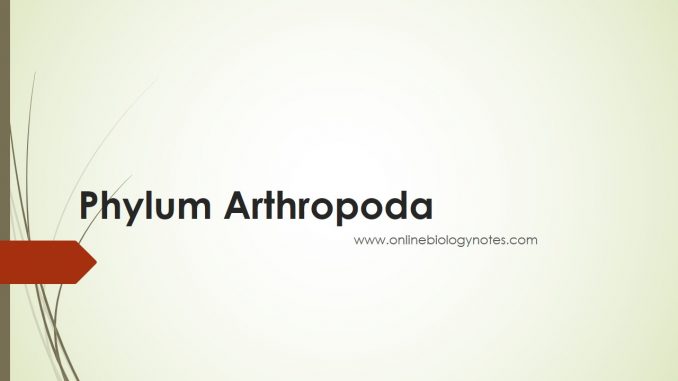
Gereral Characteristics of Phylum Arthropoda
- Arthros; Jointed, podos; Foot)
- Kingdom: Animalia
- Habitat: mostly terrestrial, also aquatic
- Insects are the most successful life form on the planet: they make up more than half of all living things on Earth
- Body has Three-part: head, thorax, abdomen.
- Body is metamerically segmented
- Three pairs of jointed legs (6 legs).
- Compound eyes which contain several thousand lenses leading to a larger field of vision.
- They possess two antenna.
- Symmetry: bilateral
- Germ layer: triploblastic
- Grade of organization: organ system grade
- Coelom: hoemocoel
- Chitinous (hard) exoskeleton, no bones or a skeleton
- Respiratory system: by general body surface, by gills, tracheae or book lungs
- Circulatory system: open type with dorsal heart.
- Excretion: malpighian tubules or green gland
- Nervous system: dorsal brain with ventral nerve cord
- Sexes are separate. Sexually dimorphism is present
- Fertilization: internal.
- Development: direct or indirect with larval stages.
Classification of Phylum Arthropoda
Arthropoda is classified into five classes on the basis of body divisions, body appendages, habitat, organs of respiration and modes of excretion.
Class 1 Crustacea
(Crusta: shell)
- Habitat: They are mostly aquatic, few are terrestrial and very few are parasitic.
- Cephalothorex: Head is often fused with thoracic segments to form cephalothorax.
- Thorax and abdomen have a pair of biramous appendages in each segment.
- Respiration: through the gills or general body surface.
- Excretory organs are modified coelomoducts which may either maxillary glands or antennary glands.
- Examples: Cancer (crab), Palaemon (Prawn), Daphnia (water flea) etc.
Class 2 Myriapoda
(Myrios: ten thousand; podos: foot)
- Habitat: Mostly terrestrial.
- Many appendages: Body is long with numerous segments each having one or two pairs of legs.
- Head is distinct with antennae, a pair of eyes and two to three pairs of jaws.
- Excretion: by malpighian tubules.
- Respiration: by trachea.
- Examples: Julus (Millipede), Scolopendra (Centipede), Spirobolus etc
Class 3 Insects
(Insectus: divided)
- Habitat: Mostly terrestrial and rarely aquatic
- Body divided into three regions: head, thorax and abdomen.
- Thorax has three segments, each bearing a pair of leg and a pair of wings found on second and third segments.
- Abdomen has 7-11 segments without appendages.
- Respiration: by tracheae, gills etc.
- Excretion: usually by malpighian tubules.
- Examples; Pieris (Butterfly), Periplaneta (Cockroach), Tabernus (Housefly), Mosquiotes, Ants, etc.
Class 4 Arachnida
(Arachne: spider)
- Habitat: mostly terrestrial and rarely aquatic
- Body is usually divided into cephalothorax and abdomen.
- There are four pairs of legs attached to the cephalothorax.
- Respiration: by tracheae or book lungs or gills.
- Excretion: by malpighian tubules or coxal gland or both.
- Examples: Aramea (Spider), Palamnaeus (Scorpion), Limulus (King Crab), etc
Class 5 Onychophora
(Onychos: claw; phoros: bearing)
- Habitat: mostly terrestrial
- Small sized arthropods
- Body is segmented
- Respiration: by tracheae.
- Excretion: by nephridia
- Examples: Paripatus
